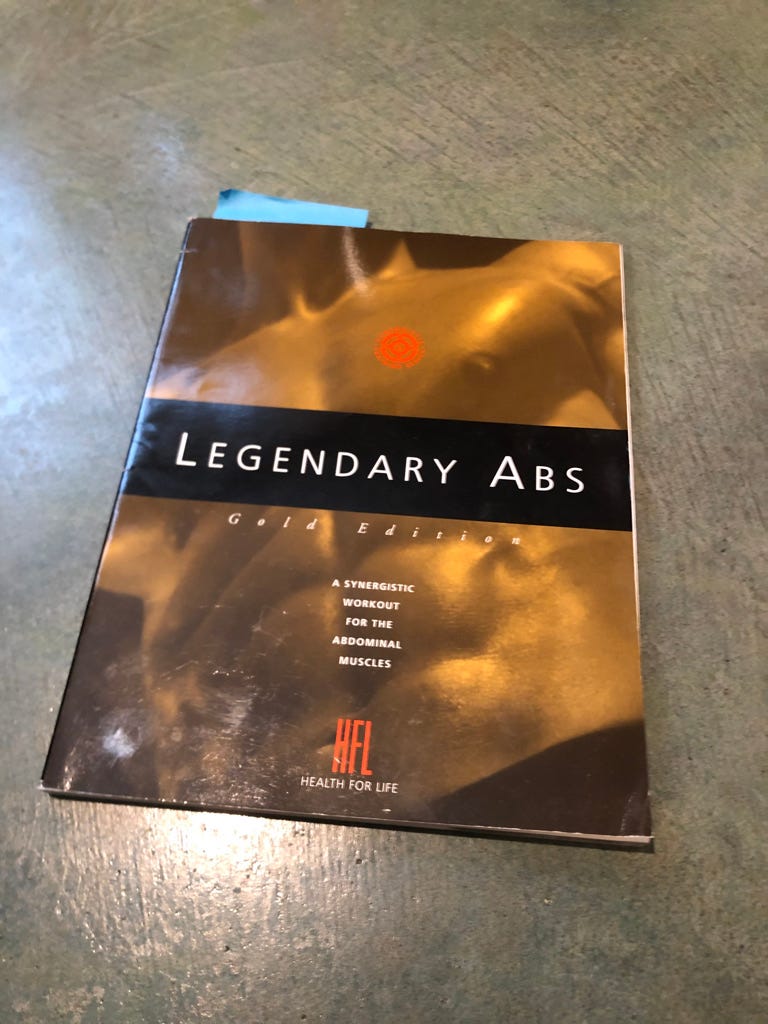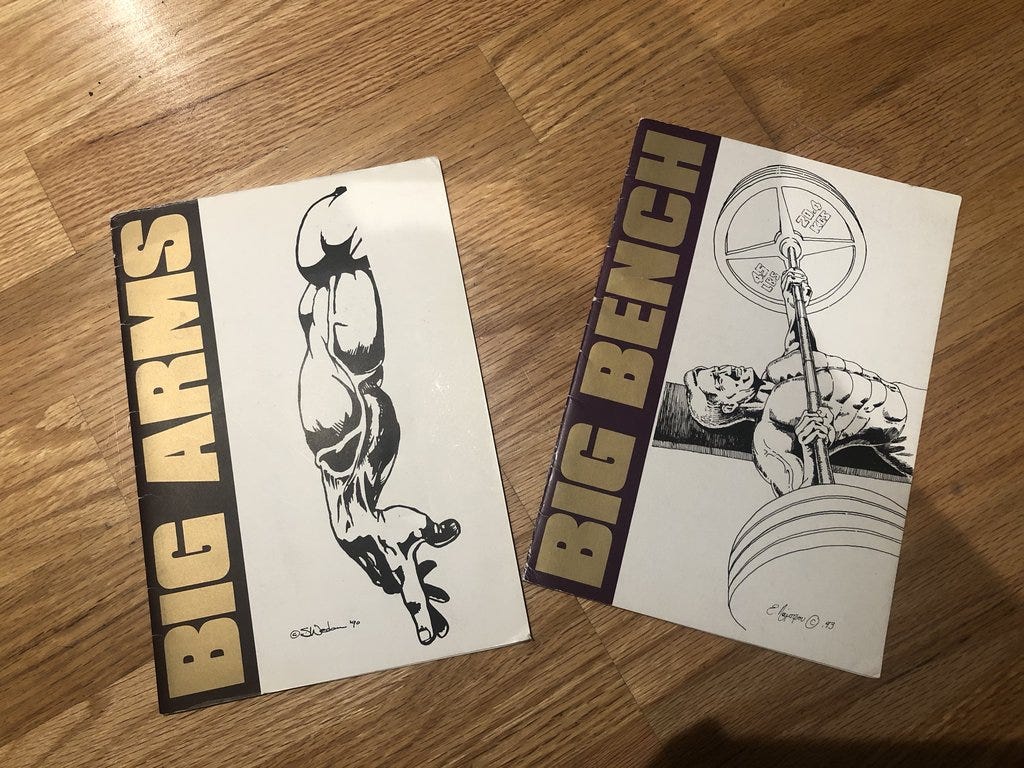The Four (Okay, Five) Horsemen of The HIIT Apocalypse
When I first picked up the weights back in 2009 at age 14, I was beyond enthusiastic.
Unfortunately, I immediately dived into the high-volume bodybuilding dogma of FLEX Magazine and the like, albeit not to the degree that many jump into.
Let’s recount the salty, sordid tale
In the spring of 2009, back when I was just a wee freshman in high school, I joined my school’s track and field team.
As a warm-up for each practice, we would do an ‘8-minute-abs’ training circuit, cycling through various abdominal exercises and super-setting them with push-ups.
This was the first time in my life when I actually thought about what happens to your body when you exercise.
I remember it clearly, thinking, “Whoa, I could get a six-pack on my stomach from this!! On me!!”
I was hooked.
The second I got home from practice I ran into my dad’s office and belted out, “Dad, how do you get a six-pack?!”
He went over to his bookshelf and proceeded to pull out a series of Health for Life Bodybuilding Manuals—a now-defunct company from the mid-to-late 90s.
The most notable at the time, was their book Legendary Abs.
Needless to say, this is exactly what my young mind was searching for.
Six Months Later
I hadn’t gained a single pound of muscle.
Seriously.
I can’t quite remember how tall I was at the time, probably somewhere between 5’ 8” and 5’ 10”, and I still weighed a measly 135 Lbs, sopping wet.
It was depressing.
The dark cloud that easily comes over a teenager when their goals and desires seem to be out of reach, had encompassed me totally.
Fortunately, my father had been bitten by the bodybuilding bug as well.
M sudden fascination and enthusiasm in the bodybuilding-sphere had reignited my father’s own interest, and he’d consequently been doing his homework.
Like myself, my father had been surfing the web and doing research, getting himself caught up with the current literature on the subject after his hiatus since his Health for Life days.
Health for Life spouted a high-volume and high-intensity approach.
In other words, they opted for many sets and exercises using lighter weights, alongside little-to-no rest between sets and exercises.
This approach may work for some, but it definitely did not work for my dad and I.
I do remember the workouts being extremely exhausting—on both a cardiovascular and muscular level.
For those interested, I’ll go over and review their books at a later time.
Enter Stuart McRobert
This man was my saving grace.
After experimenting and tweaking the Health for Life routines with little to no success, my dad and I decided—what the hell—let’s give this ‘low-volume approach guy’ a chance.
We had his book brawn, along with a few others, but one stood out in particular to me: his old school pamphlet Big Arms.
This one made the most sense to my teenage brain, as I, naturally, wanted big arms myself.
It honestly took a little courage to start, since I wanted to achieve my bodybuilding goals so badly, yet I was afraid my ‘gains,’ even when I had none, would melt away with this low volume training style.
We began the prescribed ‘Stage Two’ workout routine—stage one seemed like too little volume to me at the time, and I didn’t want to be too risky with this low volume stuff—which was as follows:
Monday
-
Squat to parallel - 5 x 5
-
Bench Press - 5 x 5
-
Pulldown to the Chest - 5 x 5
-
Seated Press Behind Neck - 5 x 5 - We opted for the regular press to the front
-
Standing Calf Raise - 2 x 20 - Same weight for both sets
-
Crunch Sit-up - 1 x 40-50
Wednesday
-
Incline Press (45° Incline) - 5 x 5 - 30° is superior in my opinion
-
One-arm Dumbbell Row - 5 x 5
-
Barbell Shrug - 5 x 5
-
Crunch Sit-up - 1 x 40-50
-
Side Bend - 1 x 30-40
Friday
-
Squat to parallel - 5 x 5
-
Close-Grip Bench Press - 5 x 5
-
Deadlift - 5 x 5
-
Standing Calf Raise - 2 x 20 - Same weight for both sets
-
Crunch Sit-up - 1 x 40-50
…and the rest, as they say, is history.
Three Months Later
I finally weighed myself again a few days before thanksgiving.
I remember it vividly.
My mom’s cousin—so my second cousin?—was an amateur bodybuilder who competed in the 70s and 80s in both England and the United States, so I couldn’t wait to tell him.
I weighed 155 Lbs.
I was absolutely ecstatic when I stood on that scale, and almost couldn’t believe it.
I ran around the house fist-pumping in the air and then, of course, ran off to announce my newfound weight gain to my father.
After discovering the life-changing works of Stuart McRobert, I ultimately discovered the other Horsemen of The HIIT Apocalypse as I continued to study and research bodybuilding alongside my actual training.
The Five Horsemen
In no particular order, I present to you the Godfathers of low-volume, high-intensity bodybuilding.
As I stated above, there are many other men and women who have made contributions to the HIIT space, but I chose these five because, in my opinion, they are the ones who helped refine and optimize the practice while also pushing it to the masses.
And, most of all, impacted my training.
Stuart McRobert
I consider Stuart McRobert, “The People’s Bodybuilder.”
He made bodybuilding realistic for the ‘every man,’ and illustrated to all that the routines you see in bodybuilding magazines are a pile of baloney.
Likewise, he also opened many eyes to a harsh reality: everyone in those magazines pushing the high volume routines is pumped up on anabolics and bodybuilding drugs.
It was all a lie.
You can visit his website here, and find his books here.
Martin Berkhan
The self-proclaimed Khan of Intermittent Fasting.
Martin is the OG proprietor of Intermittent Fasting and, while he isn’t necessarily the one who made it go mainstream, I’d argue that he is the original pioneer who combined intermittent fasting with a bodybuilding lifestyle.
Shortly after my success with Stuart McRobert’s workout style, a year later or so—perhaps earlier—I came across leangains.com.
Once again, my 'workout lifestyle,’ for lack of a better word, was forever changed.
I already suffered gut issues—more on that later—he intermittent fasting greatly improved the quality of my digestion, alongside my ability to bulk and cut.
I already strongly disliked the concept of eating four to six small meals throughout the day, and much preferred larger portions, so I was sold on his eating style immediately.
Lastly, after nearly ten years of waiting, Martin did finally release his own book on the subject, which can be an excellent primer for those new to the concepts.
Mike Mentzer & Dorian Yates
You could call these two my, ‘bodybuilding idols.’
Mike Mentzer was the ‘Thinking Man’s Bodybuilder,’ whereas Dorian is in many ways his successor.
Mentzer, alongside Arthur Jones—who I will discuss below—was another big name in the industry who began to push the idea of shorter, yet more intense workouts.
In fact, Stuart McRobert has cited multiple times that he would often refer to Mentzer’s thoughts and writings on the subject.
Mentzer had become dissatisfied with the ‘marathon workouts’ that were currently in use by most bodybuilders of his era and went in search of another way.
Mike Mentzer introduced his take on HIIT, which he called, Heavy Duty.
His final treatise on the subject is found in this book, however, I found this compilation of his writings to cover the subject in more detail.
It also looks like there is a website hosted in his name that posts quite a bit of writing.
Dorian Yates, on the other hand, could almost be called Mentzer 2.0.
He read the works of Arthur Jones, later trained with Mentzer, and in my opinion, subsequently refined the low-volume HIIT-style approach.
Moreover, when Dorian arrived on the scene in the 90s, the dot-com boom was only beginning, putting him at the forefront of the methodology.
Finally, Dorian also systematically curated his exercise selection for each workout, which resulted in his advocacy for the notorious Nautilus Pullover Machine.
Arthur Jones
The true GrandDaddy of low-volume, high-intensity bodybuilding.
It’s a shame that many actually haven’t heard of this guy.
Arthur Jones was an extremely successful and wealthy entrepreneur, and only because of a personal interest in exercise science, went on to found Nautilus, Inc.
Nautilus is the company responsible for the Pullover Machine shown above, in addition to the Workout Machine Renaissance that took the western world by storm.
Like Arnold Schwarzenegger, Nautilus was another vehicle that fueled the growth and popularity of bodybuilding and attending a gym to exercise.
My Current Training
I have been an avid follower of the low-volume, HIIT-style approach to training ever since I ran the Big Arms program above.
It’s worth noting that I have experimented A LOT by manipulating other variables of training—namely the number of sets, exercise selection, order, and so on—yet have stuck with abbreviated HIIT training all the way through.
Don’t get me wrong, I have experimented with high volume and varying levels of intensity at times, but I’ve never had any breakthroughs that have pushed me to stick with it.
Nothing has ever elicited the same growth response I get from HIIT.
Over time, I’ve actually increased the amount of intensity I use, while lowering the volume.
These days, I typically will perform two sets for the first exercise for whatever body part I am training—or section of that body part—then subsequently do one set for all additional accessory exercises for the day.
For example, if I am training back and calves, I will perform two sets of a pullover-type exercise, followed by one set to failure for each following back exercise.
Once I get to calves, I will once again perform two sets for the top exercise, followed by one set for any additional exercises.
Occasionally, I’ll do one set only all the way through, forgoing the second set for the top exercise.
Just for Fun: How Would I Change the Routine Above?
Just for kicks, let’s create a ‘2.0’ version of the routine above.
In my opinion, this is how it’d be done:
Monday
-
~5 Minute Warm-Up with Plyometrics, Calisthenics, or Cardio
-
Squat to Parallel or Leg Press - 2 x 8-10
-
Incline (30° Incline) Dumbbell Press - 2 x 6-10
-
Dumbbell, Cable, or Machine Lateral Raise - 2 x 8-10
-
Standing Calf Raise - 2 x 8-10
-
Tibia Raise or Tibia Pull - 2 x 8-10
-
Seated Calf Raise Machine - 1 x 8-10
-
Stretch
Wednesday
-
~5 Minute Warm-Up with Plyometrics, Calisthenics, or Cardio
-
Machine Pullover (or Dumbbell/Cable Pullover) - 2 x 6-8
-
Neutral Grip or Supinated Pulldown - 1 x 6-8
-
Wide Grip Cable Row - 2 x 6-8
-
One-Arm Yates Dumbbell Row - 2 x 6-8
-
Seated Dumbbell Shrug - 1 x 6-10
-
Dumbbell or Cable L-Fly - 1 x 6-10
-
Stretch
Friday
-
~5 Minute Warm-Up with Plyometrics, Calisthenics, or Cardio
-
Romanian Deadlift or Glute Ham Raise - 2 x 8-10
-
Cable or Dumbbell Bent-Over Reverse Fly - 2 x 8-10
-
Dumbbell Incline Curl - 2 x 8-10
-
Dumbbell Hammer Curl - 2 x 8-10
-
Dumbbell Close-Grip Bench Press or Triceps Dip - 2 x 8-10
-
Grip Work with Super Gripper or Hang on Pull Up Bar for as Long as Possible - 2 x 6-8 or 2 Sets hanging for as long as possible.
-
Stretch
What’s the logic behind this routine?
The rep schemes?
Exercise selection?
That’s for you to find out in future content, or you can go ahead and hire me now.
Subscribe to this letter, or get one of my one-time plans or coaching packages once available next week.
Pour Conclure
If you’re struggling with a high-volume routine, simply want to save some time, or just mix things up, HIIT may be worth your while.
You could end up changing your entire training style and philosophy.
I certainly did.
Until next time, friends.
Alexander Smout
Questions & Comments: Please feel free to ask questions and leave comments as it relates to the topic(s), or if you’d just like to say hello—I want to hear from you!




